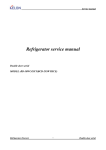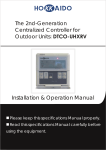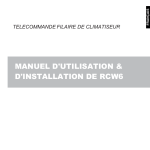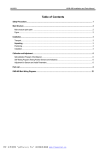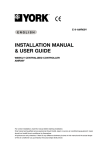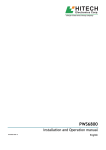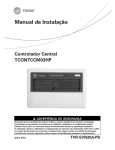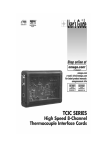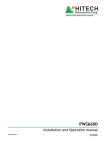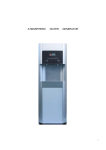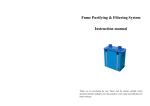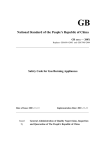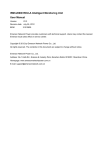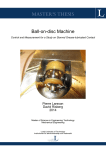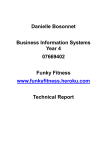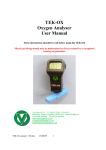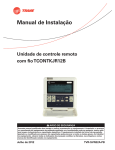Download Owner`s Manual AMR03Y
Transcript
UG-AMR03Y/E ENGLISH OWNER’S MANUAL THE 2ND-GENERATION CENTRALIZED CONTROLLER AMR03Y Please read this installation manual carefully before installing your air conditioner. Please keep this manual in a safe place for future reference. This manual many be subject to change without notice for purpose of improvement. Applicable model: AMR03Y/E 2. Installation assemblies prepared on the site Serial CONTENT PAGE I.Installation part Packing list and precautions.............................................1 Notes to installation...........................................................1 Installation procedure........................................................2 Wiring procedure...............................................................2 Safety precautions............................................................2 System wiring instruction..................................................2 II. Operation part Basic conditions of operating the electric controller..........2 Function categories of electric controller..........................2 Functions of components..................................................2 System composition.......................................................3 Keywords and general function description...................3 Schematic diagram of centralized controller keys..........3 Electric control function description (keypad operation instruction)........................................3 General display data entries........................................4 LCD display description...............................................5 Fault and protection code table....................................5 Technical indices and requirements...............................6 Chart.1............................................................................8 Chart.2............................................................................9 Chart.3..........................................................................10 Chart.4..........................................................................11 Chart5 (LCD full display diagram)................................12 Chart.6,7,8,9.................................................................13 Thank you for your confidence in YORK . YORK 2nd-Generation Centralized Controller This specification manual describes the conditions of operating the centralized controller and its control functions. This specification manual is applicable to centralized controllers. But the functions available from the centralized controller described herein or the displayed data need support of the main control board of the air conditioner. For convenience of future reference, keep this manual properly after reading it. For any question, contact the distributor. I. Installation part Name (Install No. 1 Quantity Remarks wall) 3-core control 2 PCS shielded cable RVVP300/300 3x0.75mm 2 One for communicating with network interface module; the other for communicating with the computer. 2 3-core cable 1 PCS RVV-300/500 For power supply 3x1.5mm 2 of monitor 3 Switch box 1 PCS -------- -------- 4 Wire pipe (jack 2 3 PCS / -------- -------- -------- For binding cables(as casing pipe, captive nut) 5 Tighten strip Several pieces the case may be) Notes to installation Notes to installation of centralized controller: 1. Power supply of the centralized controller. Connect the 220V~50Hz power supply to the L and N sides of the terminal on the back of the centralized controller. 2. Do not place the signal cable and power cable of the centralized controller into the same wire pipe. An interval of 300~500mm should exist between the two pipes. 3. The main signal cable of the centralized controller shall not exceed 1200m. 4. No intermediate joint is allowed for the shielded cable. If joints are inevitable, crimp it with the terminal. 5. After the centralized controller is connected, do not use megohmmeter to inspect insulation of the signal cable. 6. Wiring mode of the centralized controller and the network interface: The communication port between the centralized controller and the network interface of the air conditioner is polarity-sensitive. The X, Y and E at both sides should correspond properly. Dot not cross-connect cables. The same principles apply to the RS485RS232 of the centralized controller. Correct connection List of fittings and precautions Selected into model Correct connection 1. Packing box list of 2nd-generation indoor unit centralized controller AMR03Y. Check whether the assemblies are complete. Serial Name Quantity Remarks 2nd-generation indoor 1 PCS AMR03Y/E No. 1 Incorrect connection Incorrect connection unit centralized controller 2 Fastening cross 6 PCS groove pan head GB845/ST3.8X25-C-H (S) self-tapping screw 3 Fastening plastic 6 PCS 6X30 1 PCS YDS06IU-012a 2 PCS 120 ohms< expansion pipe 4 Installation & Operation Manual 5 Matching resistance I&O manual 1 System wiring instruction Installation procedure (see in Chart.1) I. Procedure of installing electrician switch box of centralized controller The size of the centralized controller wire depends on the length. Use a wiring pipe adaptable to the wires of the centralized controller to perform installation. Insert the flathead screwdriver into the concave on the upper side of the box, and rotate slightly to open the upper cover of the centralized controller. 1. Wiring diagram of building network air conditioning system. Wiring procedure (see in Chart.2) Wiring diagram with good communication effect Network air conditioner wiring diagram (two types for indoor unit: (1) The main control board needs an external network interface module; (2) Network interface module is built in the main control board). NOTE The RS485-to-RS232 module in the wiring diagram and the wires are put into use only when the network system needs to be connected with the computer. One computer can be connected with 16 centralized monitors as a maximum. Namely, a maximum of 16X64=1024 indoor units can be connected. The centralized controllers are differentiated by address bits. The configurable range is 0~15. No duplicate address of centralized controller is allowed in a unified network. Wiring diagram with poor communication effect (not recommended because it may lead to poor communication) 2. System wiring diagram of centralized monitoring and indoor unit of air conditioner Both of the following wiring modes of centralized monitor and indoor unit are applicable: (Quantity of indoor units connected with each centralized monitor is less than or equal to 64). Indoor unit Indoor unit Indoor unit Indoor unit Indoor unit Indoor unit Centralized controller Indoor unit Indoor unit Indoor unit Indoor unit Indoor unit Indoor unit Safety precautions ! ! ! Read the safety precautions carefully before installing the unit. Stated below are important safety issues that must be obeyed. The meanings of all parts are as follows: Warning Note Means improper handling may lead to personal injury or property loss. Means improper handling may lead to personal death or severe injury. ! Upon completion of the installation, check whether the trial run is normal, and deliver the user's manual to the user. Warning Please entrust the distributor or professionals to install the equipment. Installation by unauthorized persons may lead to imperfect installation which may result in electric shock or fire. Adhere to this installation manual. Improper installation may lead to electric shock or fire. Reinstallation must be performed by professionals. Improper installation may lead to electric shock or fire. Do not uninstall the equipment without permission. Unauthorized uninstalling may lead to abnormal operation, heating or fire of the air conditioner. Note Do not install the equipment in a place vulnerable to leakage of flammable gases. Once flammable gases are leaked and left around the centralized monitor, fire may occur. The wiring shall adapt to the current of the centralized monitor. Otherwise, electric leakage or heating may occur and result in fire. I&O manual 2 Centralized contr oller II. Operation part B a s ic c o n d it io n s o f o p e ra t in g t h e e le c t ric c o n t ro ller (1) Applicable range of supply voltage: Input voltage: Single-phase 198V ~ 242V; AC input power supply frequency: 50Hz/60Hz compatible. (2) Operating environment temperature of electric controller: -15°C~+43°C. Operating environment RH of electric controller: RH40%~RH90%. Fu n c t io n c a t e g o rie s o f e le c t ric c o n t ro lle r Functions of the electric controller: (1) System composition (2) Keywords and general function description (3) Description of electric control functions of centralized controller (4) Technical indices and requirements Fu n c t io n d e s c rip t io n o f e a c h p a rt The locking status of the remote controller can be locked or unlocked by the computer or centralized controller separately. The locking status of the centralized controller is memorized after power failure of the centralized controller, and will not vanish after the power supply is restored, unless the command of unlocking is received. System composition 1 The centralized controller is used to perform centralized control and data query for the network air conditioner. Each centralized controller can communicate with a maximum of 64 air conditioners to make up an air conditioner LAN, and implement centralized monitoring for the air conditioners in the network. 2 The centralized controller can be interfaced with computer or gateway to implement centralized control and status query for all air conditioners in the network. It can be connected with WAN via computer or gateway to implement remote computerized control (with support of computer software). Each local computer or gateway can be connected to 16 centralized controllers as a maximum. 3 The master/slave answer mode is implemented for communication between the centralized controller and the air conditioner, between the computer and the centralized controller. In the LAN composed of centralized controller and air conditioner, the centralized controller is a master, and the air conditioner is a slave. In the LAN composed of computer and centralized controller, the computer or gateway is a master, and the centralized controller is a slave. Schematic diagram of network control system composition of air conditioner: (see in Chart.3) Mode locking function After the mode locking command is received, the command is forwarded to the air conditioner, and the centralized controller displays the mode locking flag. After the command of unlocking is received, the non-conflict mode can be selected freely. The centralized controller can also lock modes of all indoor units. Emergent shutdown and compulsory startup 5 6 Keywords and general function description 1 Power on or reset When the centralized controller is powered on or reset, all display segments of the LCD are luminous for 2 seconds and then goes off. 1 second later, the system enters the normal display status. The centralized controller is in the main page display status and displays the first page, and searches the in-service air conditioners in the network. Once the search is finished, the centralized controller enters the mode setting page, and sets the first in-service air conditioner by default. 2 Network area address of centralized controller Electric controller function description ---Keypad operation description (see in Chart.4) 1) is to query the operation status of the air conditioner. By default, the first in-service air conditioner will be queried. Through the Increase and Decrease keys, you can change the parameter page to be queried; through the Up, Down, Left and Right keys, you can change to query status of other in-service air State indication If any local keypad operation is setting the operation status of the air conditioner, the indicator is on when the signals are sent. Upon completion of the setting process, the indicator goes off. If an in-service air conditioner in the network is faulty, or the centralized controller network itself is faulty, the indicator will blink at 2Hz. conditioners. 2) Set key In other display mode, press the key to enter the setting mode. By default, it is single setting, and the first in-service air conditioner is displayed. In setting operation mode, press the key again, and the operation will be performed for all air conditioners in the network. Press the key repeatedly to shift If one or more in-service air conditioners in the network are running, including under setting of timing start/shutdown, the indicator will be luminous. Otherwise, the indicator is off. 4 Locking of centralized controller After receiving the centralized controller locking command sent from the computer, the centralized controller disables the startup/shutdown and setting of the air conditioner, and sends commands to lock remote controllers of all air conditioners in the network of the centralized controller. After receiving the unlocking command, the centralized controller enables the startup/shutdown operation, and sends commands to unlock the remote controller of all air conditioners. Query key Any time when you press the key, the selected operation mode The local computer or gateway can be connected with 16 centralized controllers for communication. Each centralized controller serves as an area of the air conditioner network. The centralized controllers are differentiated by bit selection address. The configurable range is 0~15. 3 When the emergent shutdown switch of the centralized controller is turned on, all air conditioners in the network of the centralized controller will shut down compulsorily. The centralized controller and computer and all functional modules are disabled from startup and shutdown until the foregoing switch is turned off. When the compulsory startup switch of the centralized controller is turned on, all air conditioners in the network of the centralized controller will start up compulsorily. By default, they will run in the cooling mode. The startup and shutdown operations of the centralized controller and the computer and all functional modules will be disabled (only the command of startup is sent to the air conditioner, without affecting operation of the remote controller after startup) until the foregoing switch is turned off. If the foregoing two switches are turned on concurrently, the emergent shutdown switch shall have preference. between single setting and global setting. → 3) Single → Global → Mode key In setting operation mode, press this key to set the operation →cooling → heating → supply air only → stop → In other display mode, press the key to enter the setting mode. By default, it is single-machine setting, and the first in-service air conditioner is displayed. I&O manual 3 4) Fan key In the query mode, every time when you press the key, the 11) Upward key In the query mode, every time when you press the key, the operation status data of the air conditioner corresponding to the previous row of the matrix will be displayed. If it is currently in the first row, press the key, and the data of the air conditioner corresponding to the last row will be displayed. If you hold down this key, the row will decrease one by one. In the setting mode, every time when you press the key, if it is in the single operation mode, the air conditioner corresponding to the previous row will be selected. If it is in the global operation mode, no effect will result after the key is pressed. In the main page, press the key to enter the query mode. By default, it is the first in-service air conditioner. 12) Add key In the main page or the query mode, every time when you press the key, the data of the last page will be displayed. If it is now in the last page, press the key again, and the first page will be displayed. In the setting mode, every time when you press the key, if it is in the temperature regulation mode, the set temperature will decrease by 1 °C until the highest allowed set temperature; if it is in the timing startup/shutdown time setting mode, select the upper-level set time, if no time is set, 0.0 will be displayed, if you hold down the key, the upper-level data will be selected consecutively. The specific change mode is as follows: operation status data of the previous air conditioner will be 0.0→0.5→1.0→1.5→2.0→2.5→3.0→3.5→4.0→4.5→5.0→5.5→6.0→6.5→7.0 displayed. →7.5→ 8.0→8.5→9.0→9.5→10→11→12→13→14→15→16→17→18→19 In setting operation mode, press this key to set the fan of the indoor unit of the air conditioner to run in the automatic, high, medium or low level of air. → auto 5) → low → medium → high → Time on key In setting operation mode, press this key to set the timing startup of air conditioner; press the key again to exit the timing setting, and restore the normal temperature regulation operation mode. → time on 6) → set temperature regulation → Time off key In setting operation mode, press this key to set the timing shutdown of air conditioner; press the key again to exit the timing setting, and restore the normal temperature regulation operation mode. → time on → 7) set temperature regulation → Swing key In setting operation mode, press this key to enable or disable the swing function. If all currently selected air conditioners have no swing function, no effect will result after pressing the key. 8) Leftward key If it is currently on the first machine, press the key again, and the data of the last machine will be displayed. If you hold down this key, the address will decrease one by one. In the setting mode, every time when you press the key, if it is in single operation mode, the air conditioner of the previous in-service address number will be selected. If it is in the global operation mode, no effect will result after the key is pressed. In the main page, press the key to enter the query mode. By default, it is the first in-service air conditioner. 9) Rightward key In the query mode, every time when you press the key, the operation status data of the last air conditioner will be displayed. If it is currently on the last machine, press the key, and the data of the first machine will be displayed. If you hold down this key, the address will increase one by one. In the setting mode, every time when you press the key, if it is in the single operation mode, the air conditioner of the next in-service address number will be selected. If it is in the global operation mode, no effect will result after the key is pressed. In the main page, press the key to enter the query mode. By default, it is the first in-service air conditioner. 10) Downward key In the query mode, every time when you press the key, the operation status data of the air conditioner corresponding to the next row of the matrix will be displayed. If it is currently in the last row, press the key, and the data of the air conditioner corresponding to the first row will be displayed. If you hold down this key, the row will increase one by one. In the setting mode, every time when you press the key, if it is in the single operation mode, the air conditioner corresponding to the last row will be selected. If it is in the global operation mode, no effect will result after the key is pressed. In the main page, press the key to enter the query mode. By default, it is the first in-service air conditioner. I&O manual 4 →20→21→22→23→24 13) Reduce key In the main page or the query mode, every time when you press a key, the data of the current page will be displayed. If it is now in the first page, press the key again, and the last page will be displayed. In the setting mode, every time when you press the key, if it is in the temperature regulation mode, the set temperature will decrease by 1 degree until the lowest allowed set temperature; if it is in the timing startup/shutdown time setting mode, select the upper-level set time, if no time is set, 0.0 will be displayed, if you hold down the key, the upper-level data will be selected consecutively. The specific change mode is as follows: 0.0← .5←1.0←1.5←2.0←2.5←3.0←3.5←4.0←4.5←5.0←5.5←6.0←6.5← 7.0←7.5←8.0←8.5 ←9.0←9.5←10←11←12←13←14←15←16←17← 18←19←20←21←22←23←24 14) ON/OFF key Any time when you press the key, the centralized startup/shutdown operation is performed for all current in-service air conditioners in the centralized controller network. If all in-service air conditioners in the network are in the power-off status, press the key to perform the startup operation. If it is in the mode setting page currently, and the parameters such as startup mode, temperature and air speed are selected, the air conditioner will be started according to the selected parameters. If no mode is selected currently, and the air conditioner is powered off or it is in other display page currently, and the default startup mode is: Cooling, strong air, set temperature 24°C, swing function enabled. The default startup mode is locked according to the system mode or judged according to other constraint conditions. If any conflict exists, the next conflict-free mode will apply automatically. If conflict exists for all modes, startup will be impossible. If one or more in-service air conditioners in the network (including in the timing process of timing startup/shutdown), pressing this key will shut down all air conditioners. When performing the shutdown operation, the shutdown command is issued to the air conditioners in the startup status only, and is not issued to those in the shutdown status. 15) Lock key In the mode setting mode, press the Lock key, and the remote controller of the currently selected air conditioner will be locked/unlocked. The operation mode is: If you select single-machine setting, the operation is performed for the air conditioner of the current address only. If the remote controller of the air conditioner is locked currently, issue the lock command; otherwise, send the lock command. If you does not select the single-machine mode, and the remote controller of one or more currently selected air conditioners is locked, issue the unlock command; if the remote controllers of all currently selected air conditioners are in the non-locked status, issue the remote controller lock command. When the remote controller of the air conditioner is locked, the air conditioner does not receive remote control signals from the remote controller or wire controller until the remote controller is unlocked. Press the Query key and then press the Lock key, and the keys of the centralized controller will be locked or unlocked. If the keys are currently locked, press the foregoing keys concurrently again, and the keys will be unlocked; if the keys are currently unlocked, press the foregoing keys concurrently, and the keys will be locked. If the keys are locked, pressing of any key other than the Unlock key will be ineffective. In the unified setting page, press the Up key and the Lock key concurrently to lock all air conditioner modules in the network. The mode locking is cancelled when the key is pressed again. Note: When you lock or cancel locking, the corresponding icon indication appears or disappears only after all the attached air conditioners are set completely, so it takes a time period. When the number of attached air conditioners is high, wait patiently. 16) Confirmation key In the setting mode, press the key to send the currently selected mode status and the auxiliary function status to the selected air conditioner, and display the mode setting operation results. After you select the operation mode and auxiliary function status information of the air conditioner, if you do not press the confirmation key, the selected information will not be sent to the air conditioner, and will not affect the current operation of the air conditioner. The operations of remote controller locking and unlocking need no pressing of the confirmation key. The command information is sent directly after the locking key is pressed. 17) Reset key Anytime when the reset key is pressed, the centralized controller will reset. The result is the same as the result of restoring power-on after power failure. General display data entries 1) 2) General display data is displayed in all display pages. a. Under the interconnected control of the computer or gateway, the data is displayed in graphic. Otherwise, no data is displayed. b. If the centralized controller is connected with the functional module for communication, the data is displayed in graphics. Otherwise, no data is displayed. c. If the centralized controller is connected with the SMS remote control module for communication, the data is displayed in graphics. Otherwise, no data is displayed. d. If the centralized controller is connected with the telephone remote control module for communication, the data is displayed in graphics. Otherwise, no data is displayed. e. In normal operation of the centralized controller, the periodical cycle module communicates with the network interface module, and the data is displayed dynamically and cyclically (blank). f. In the centralized control locked status or the keypad locked status, the locking flag is displayed. After unlocking, it is not displayed. In the centralized controller locked status, the flag blinks at 0.5Hz; in the keypad locked status, the flag is displayed constantly. If both of them are locked concurrently, the flag is displayed constantly. g. In the setting page, if the selected air conditioner is in the remote controller locked status (in case of non-single machine operation, as long as one machine is in the remote controller locked status, it is deemed the locked status), the flag is displayed constantly. h. If all indoor units lock the cooling mode, this flag will display; if all indoor units lock the heating mode, this flag will display. Data display handling 1. Indoor unit code (address) display: Display range: 00~63; with “#” being luminous concurrently. 2. Indoor temperature display: Display range: 00~99°C. “°C” and “indoor temperature” are displayed concurrently. If the temperature is higher than 99°C, “_99°C” is displayed. If the temperature value is invalid, “—” is displayed. 3. If timing startup/shutdown is set, the flag is displayed. 4. T3, T2A and T2B display: In the single-machine query page, display can shift between “T3”, “T2A” and “T2B”, and the temperature value is displayed concurrently, with the corresponding “°C” being luminous. 5. In case of air conditioner fault or protection, the corresponding fault code or protection code can be displayed. I&O manual 5 6. Liquid crystal matrix display description: (see in Chart.5) Description of the setting page (see in Chart.8) The LCD displays the setting page, and queries the air conditioner with the address of 08. The mode of the air conditioner with the address 08 is: Cooling, strong air, swing on, indoor temperature 28°C, set temperature 22°C, cooling. In the matrix, only the big black dots from (08, 00+) to (16, 00+) are luminous. It indicates the air conditioners with the addresses from 08 to 16 are in service. The centralized controller communicates with the computer normally. 3. 1) 2) 3) 1. 2. 3. The liquid crystal matrix is composed of 4*64 grids, and each grid is composed of two blocks of different sizes (as shown in the above figure). The matrix includes horizontal coordinates 00-15 on the upper side and vertical coordinates 00+, 16+, 32+ and 48+ on the left side, which indicate the address of the indoor unit. The sum of the horizontal coordinate and the vertical coordinate of the grid is the address of the grid. Each grid corresponds to an indoor unit of this address. One grid is composed of two blocks of different sizes. The status indication table is as follows: Status Constantly on Object Big black block In-service Small black block Slow Fast blink blink Out of Selected service Fault of Power on indoor unit Power off LCD display description (see in Chart.6) 1. 2. 1) 2) 3) Description of the standby page 1) The LCD displays the standby page, 60 air conditioners are in service, of which 28 are powered on and 32 off. 2) In the matrix, the big dots of (00, 16+) and (15,32+) are luminous, and the small dots are not luminous. It indicates the 32 air conditioners with the addresses from 16 to 47 are powered off. 3) In the matrix, the big and small dots of (09, 48+) and (12, 48+) are not luminous. It indicates the four air conditioners with the addresses from 57 to 60 are outside the network. 4) All other big and small dots in the matrix are luminous. It indicates all other air conditioners are in the network and powered on. 5) The address of the air conditioner is sum of the coordinates. For example, the address of (09, 48+) is 09+48=57. 6) The centralized controller keypad is locked, and the centralized controller communicates with the computer normally. Description of the query page (see in Chart.7) The LCD displays the query page, and the air conditioner with the address of 08 is being queried. Mode of the air conditioner with the address 01 is: Cooling, strong air, swing on, indoor temperature 22°C, set temperature 20°C, cooling mode “lock”. In the matrix, only the big and small black dots at (00, 00+) and (01,00+) are luminous. It indicates the in-service and power-on status of the air conditioners with the addresses of 00 and 01. The centralized controller communicates with the computer normally. I&O manual 6 4. 1) Fault page display description (see in Chart.9) Query the air conditioner with the address of 08 in the query page. The air conditioner with the address of 08 is faulty, and the fault code is 08. The big black dot below (08, 0+) blinks. 2) In the matrix, only the big and small black dots from (00, 00+) to (16, 15+) illuminate. It indicates the in-service status of the air conditioners with the addresses of 00 and 01. 3) The centralized controller communicates with the computer normally. Fault and protection code table Fault code EF Fault content Other faults EE Water level detection faults ED Outdoor unit fault protection EC Cleaning fault EB Inverter module protection EA Over-current of compressor (4 times) E9 Fault of communication between main board and display board E8 Air speed detection out of control E7 EEPROM error E6 Zero crossing detection error E5 T3 or T4 or digital compressor discharge temperature sensor fault E4 T2B sensor fault E3 T2A sensor fault E2 T1 sensor fault E1 Communication fault E0 Phase order error or phase loss 07# 06# 05# 04# 03# 02# 01# Fault of communication between centralized controller and computer (gateway) 00# Fault of communication between centralized controller and functional module Fault of communication between centralized controller and network interface module Fault of communication between network interface module and main control board Description Protection code Protection content PF Other protection PE Reserved PD Reserved PC Reserved PB Reserved PA Reserved P9 Reserved P8 Over-current of compressor P7 Power supply over-voltage under-voltage protection P6 Discharge low pressure protection P5 Discharge high pressure protection Description and P4 Discharge pipe temperature protection P3 Compressor temperature protection P2 Condenser high-temperature protection P1 Anti cool air or defrost protection P0 Evaporator temperature protection Te c h n ic a l in d ic e s a n d r e q u ir e m e n t s 1. 2. EMC and EMI comply with the CE certification requirements. The electric safety complies with the requirements of GB4706.32-2004 and GB/T7725-2004. I&O manual 7 Installation dimensions: As shown in the figure on the right side. Installation screw holes (4 holes) Rotate the flathead screwdriver slightly toopen the upper cover (at points). Screws for fixing the centralized controller (GB845/ST3.9*25) Holder Address bits Bit location Address range a 00 ~ 15 Upper cover Emergent Emergent stop start switch switch Power cable interface of centralized controller (198V~242V)/(50 / 60HZ) Communication interface with computer Communication interface with indoor interface (Chart.1) I&O manual 8 RS232 Pin hole: for connection to computer COM por t Matching resistance of communication end is 120 . RS485 Conver ted RS232 module One centr alized contr oller can be connected to 64 indoor units as a maximum POWER One centralized controller can be connected to 64 indoor units as a maximum POWER One centr alized controller can be connected to 64 indoor units as a maximum Centr alized contr oller One centr alized contr oller can be connected to 64 indoor units as a maximum POWER Centr alized contr oller (Chart.2) I&O manual 9 a i r co n d i ti o n e r Centralized controller Local computer Network interface T he network interface may be integrated into the indoor unit or main contr ol board. ,QWHUQHW A maximum of 64 pieces A maximum of 16 pieces (Chart.3) I&O manual 10 mode of the air conditioner as cooling, heating, or air supply. (Chart.4) I&O manual 11 1 . I n t he s e tt i n g p a ge , p r e s s t h e “ L o c k ” k ey t o lo c k o r u n l oc k t h e r e mo t e c o n t r o ll e r. 2 . I n t h e u n if ie d s et t in g p ag e , p r es s t h e “ U p” k e y a n d t he p r es s t he “ L oc k ” k e y to lo c k o r u n lo c k t h e mo d e. 3 . Af t e r pr e s s i n g t h e “ Qu e r y ” k e y, p r e s s t h e “ L o c k ” k ey t o l oc k o r u nl o c k t h e k e y p a d o f t h e c en t r a l iz e d c on t r o l le r. (Chart.5) 12 H ou r I n do o r t e m p e r a t u re C om p ut e r c o m m u ni c a t i o n T im i n g O N / O F F m ar k M o d e s e le ct i o n : A u t o , co o li n g , d e w e t t in g h e a t in g Ai r s u p p ly s p e e d Te m p e r a t u r e p ar am e t e r F a ul t an d p r o t e c t io n c o d e S M S m o d ul e c o m m u ni c a t i o n F u n c t i o n m o d u le c o m m u n i c at i o n D ew e t ti ng f u nc t io n Te l e p h o n e m o d u l e c o m m u n ic a t io n C oo li ng m od e l oc k i ng H ea tin g m o de oc k i ng R em o t e c o ntr ol le r l oc k i ng K e y lo ck in g Ve n t i l a t i o n E le c tri c au x il ia r y he ati ng f un c t i on S w i n g f u n c ti o n F u ll d i s p la y o f L C D C om m u ni c ati on s t atu s D i sp l a y o p e r a t i o n s t a t u s : Q u e r y, s e tt i n g , g r o u p i n g , o p e r a ti o n S etti ng m ode (1.6) I&O manual (1.6) (Chart.6) (Chart.7) (Chart.8) (Chart.9) I&O manual 13 DE - COMMISSIONING DISMANTLING & DISPOSAL This product contains refrigerant under pressure, rotating parts, and electrical connections which may be a danger and cause injury! All work must only be carried out by competent persons using suitable protective clothing and safety precautions. Read the Manual Risk of electric shock Unit is remotely controlled and may start without warning 1. Isolate all sources of electrical supply to the unit including any control system supplies switched by the unit. Ensure that all points of electrical and gas isolation are secured in the OFF position. The supply cables and gas pipework may then be disconnected and removed. For points of connection refer to unit installation instructions. 2. Remove all refrigerant from each system of the unit into a suitable container using a refrigerant reclaim or recovery unit. This refrigerant may then be re-used, if appropriate, or returned to the manufacturer for disposal.Under No circumstances should refrigerant be vented to atmosphere. Where appropriate, drain the refrigerant oil from each system into a suitable container and dispose of according to local laws and regulations governing disposal of oily wastes. 3. Packaged unit can generally be removed in one piece after disconnection as above. Any fixing down bolts should be removed and then unit lifted from position using the points provided and equipment of adequate lifting capacity. Reference MUST be made to the unit installation instructions for unit weight and correct methods of lifting. Note that any residual or spilt refrigerant oil should be mopped up and disposed of as described above. 4. After removal from position the unit parts may be disposed of according to local laws and regulations. UG-AMR03Y/E ENGLISH















